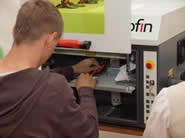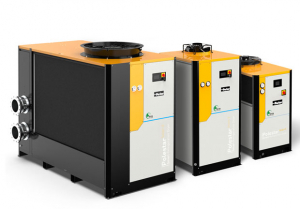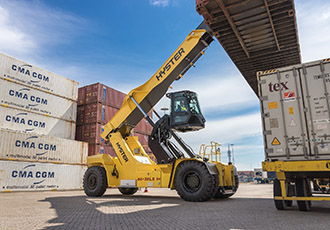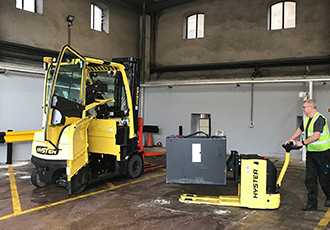ROFIN’s Marathon Marking Session
18th May 2010
Source:
Rofin-Baasel UK Limited

Laser marking has found its way into a host of different applications and indeed is now commonplace in many industries. One of the more unusual application scenarios for the technology however is marking medals with individual names and event timing parameters at sporting events.
Wherever a major sporting event takes place in Europe, Klaus Huber and Marion Hillenbrand, together with their ROFIN laser markers, can be found preparing to mark the many hundreds of medals which will be presented to competitors. In certain cases, MSM Sportvermarktungs GmbH often marks several thousand medals with live data received from the timekeepers during the course of an event.
Laser marking under canvas
The Berlin Marathon in 2009 is typical of the events attended by MSM. Soon after each of the 40,000 competitors cross the finish line, they will start to appear in the temporary marking facility, set up under canvas and close to the timekeeper’s position. Here, Klaus Huber uses a collection of four ROFIN laser marking systems to engrave competitor’s names and personal running times on to their medals. The impressive array of hardware used includes: an RS marker, two EasyMark systems and a PowerLine F20 fiber laser. The oldest of these systems has been in active service with MSM for over a decade.
This is a truly unusual application, as a sporting event is probably the last place you would expect to find a laser marking system. Additionally, there is probably no other laser marker which has travelled more miles than Huber’s RS marker. It has, after all, covered more than 120,000 miles on the road and has been installed and dismantled more than 300 times.
Huber and Hillenbrand originally came from competitive swimming sports. In 1999, MSM became involved for the first time in helping to organize the Swimming World Championship. At that time they had developed plastic name tags for the participants for use at the entry security check points. Not only were these tags individualized using the laser markers but the complete design of the 5,000 medal blanks was also produced by laser. This is where the concept of using a laser to mark competitor’s medals was born, an idea which has since been patented. The Munich Marathon in 2001 was MSM’s first mobile laser marking event and today the company and their ROFIN lasers, are represented at more than 70 sports events across Europe each year.
Lasers, Laptops and Lego!
MSM pretty much has the monopoly in just-in-time laser marking medals, which is not surprising given the complexity of the task. The laser marking systems have to be transported, set-up and put into operation, often under challenging circumstances. The entire system comprises at least as many laptops as lasers and a complete Ethernet network connected to the organisers timekeeping system. And, of course, there are many different software packages required to control the lasers, including bespoke back-ends to enable communication with the various time-keeping data bases. MSM normally have to install all of this only a few hours in advance of a major sports event – in a temporary tent without any real time buffer and at their own risk. The laser marking process has to be fast and reliable – incorrect or failed marking costs time and the number of blank medals available at any given event is strictly limited.
Often, Klaus Huber will only see an example of the medal one day in advance of the event. This leaves little time to configure the work-piece fixture, marking fields and laser parameters. When configuring the work-piece fixture he relies on the good old ‘technology’ everybody used to play with during their childhood: Lego! Experience has shown that the little Lego bricks provide an ideal solution which can be easily adapted to the shape and size of the various different medals, quickly and easily.
The different base materials used to produce medals mean that different techniques are required to generate clear readable marks on the surface. The most commonly used version is an anthracite coloured medal. For this type of medal, the laser is used to ablate the dark oxide layers, leaving the finished mark rich in contrast and clear. For light-coloured and polished medals, dark marks are generated by the laser, providing a good contrast against the lighter background. The experience gained by Klaus Huber over the years means that he is able to set up his laser marking systems to provide perfect results every time, after only a few trials on a new medal.
ROFIN lasers keep time at up to 1500 medals per hour
There are only 2-3 seconds available to mark each medal at large events, as up to 1,500 medals per hour may have to be marked during the peak period. Also, competitors are not really keen on standing in a long queue having just ran 42 kilometers. In addition, there are often several events on the same day: marathon, shorter distances, inline-skating events, wheel-chair competitions, etc. and all of these participants are keen on having an individually marked medal
In the marking tent, one person is responsible for the correct positioning of the medal in the laser system and for unloading it once marked. Another takes care of the marking process and setting the parameters to be marked. A further member of staff is responsible for taking the medals out of the tent, and using a loudspeaker to call out the name of the runner before handing over the completed item. If everything runs like clockwork, the 4 ROFIN laser systems managed by a total of 15 operators can accept, laser-mark and hand out more than 20 medals per minute.
Laser marking under canvas
The Berlin Marathon in 2009 is typical of the events attended by MSM. Soon after each of the 40,000 competitors cross the finish line, they will start to appear in the temporary marking facility, set up under canvas and close to the timekeeper’s position. Here, Klaus Huber uses a collection of four ROFIN laser marking systems to engrave competitor’s names and personal running times on to their medals. The impressive array of hardware used includes: an RS marker, two EasyMark systems and a PowerLine F20 fiber laser. The oldest of these systems has been in active service with MSM for over a decade.
This is a truly unusual application, as a sporting event is probably the last place you would expect to find a laser marking system. Additionally, there is probably no other laser marker which has travelled more miles than Huber’s RS marker. It has, after all, covered more than 120,000 miles on the road and has been installed and dismantled more than 300 times.
Huber and Hillenbrand originally came from competitive swimming sports. In 1999, MSM became involved for the first time in helping to organize the Swimming World Championship. At that time they had developed plastic name tags for the participants for use at the entry security check points. Not only were these tags individualized using the laser markers but the complete design of the 5,000 medal blanks was also produced by laser. This is where the concept of using a laser to mark competitor’s medals was born, an idea which has since been patented. The Munich Marathon in 2001 was MSM’s first mobile laser marking event and today the company and their ROFIN lasers, are represented at more than 70 sports events across Europe each year.
Lasers, Laptops and Lego!
MSM pretty much has the monopoly in just-in-time laser marking medals, which is not surprising given the complexity of the task. The laser marking systems have to be transported, set-up and put into operation, often under challenging circumstances. The entire system comprises at least as many laptops as lasers and a complete Ethernet network connected to the organisers timekeeping system. And, of course, there are many different software packages required to control the lasers, including bespoke back-ends to enable communication with the various time-keeping data bases. MSM normally have to install all of this only a few hours in advance of a major sports event – in a temporary tent without any real time buffer and at their own risk. The laser marking process has to be fast and reliable – incorrect or failed marking costs time and the number of blank medals available at any given event is strictly limited.
Often, Klaus Huber will only see an example of the medal one day in advance of the event. This leaves little time to configure the work-piece fixture, marking fields and laser parameters. When configuring the work-piece fixture he relies on the good old ‘technology’ everybody used to play with during their childhood: Lego! Experience has shown that the little Lego bricks provide an ideal solution which can be easily adapted to the shape and size of the various different medals, quickly and easily.
The different base materials used to produce medals mean that different techniques are required to generate clear readable marks on the surface. The most commonly used version is an anthracite coloured medal. For this type of medal, the laser is used to ablate the dark oxide layers, leaving the finished mark rich in contrast and clear. For light-coloured and polished medals, dark marks are generated by the laser, providing a good contrast against the lighter background. The experience gained by Klaus Huber over the years means that he is able to set up his laser marking systems to provide perfect results every time, after only a few trials on a new medal.
ROFIN lasers keep time at up to 1500 medals per hour
There are only 2-3 seconds available to mark each medal at large events, as up to 1,500 medals per hour may have to be marked during the peak period. Also, competitors are not really keen on standing in a long queue having just ran 42 kilometers. In addition, there are often several events on the same day: marathon, shorter distances, inline-skating events, wheel-chair competitions, etc. and all of these participants are keen on having an individually marked medal
In the marking tent, one person is responsible for the correct positioning of the medal in the laser system and for unloading it once marked. Another takes care of the marking process and setting the parameters to be marked. A further member of staff is responsible for taking the medals out of the tent, and using a loudspeaker to call out the name of the runner before handing over the completed item. If everything runs like clockwork, the 4 ROFIN laser systems managed by a total of 15 operators can accept, laser-mark and hand out more than 20 medals per minute.
Similar articles
More from Rofin-Baasel UK Limited
- Rofin's Vision for Perfect perforations 8th August 2011
- ROFIN’s PowerLine L Series Designed for High-Speed Micro Material Processing 11th June 2010
- ROFIN’s Marathon Marking Session 18th May 2010
- Rofin-Baasel Receives Intel’s Preferred Quality Supplier Award For The Third Consecutive Year 19th March 2010




.jpg)







Write a comment
No comments